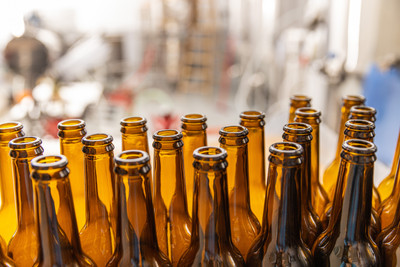Homebrewing Made Easy: Using Glass Bottles for Homemade Drinks
Posted by The Wares Team on 16th Sep 2024
Looking for a creative new project at home? Why not take a look at brewing or homebrewing? This fun activity is low-cost, creative and surprisingly easy to do, and you'll find a wide variety of recipes to use. Homebrewing is already hugely popular in the UK and there are hundreds of special interest groups where people swap ideas, recipes and successes - whether in person or online. So why not get involved?
What can I homebrew?
Traditional homebrewing involves turning your hand to making your own fruit wines, cider, beer and mead. You can do this by gathering your own ingredients and following traditional recipes to turn them into bubbling alcoholic brews, or buy kits to get started as a beginner. These projects are so much fun and can be very creative. There's also a very experimental aspect to them, as you get to grips with what works and what doesn't. But because the ingredients and equipment needed - basically glass bottles, caps and perhaps growlers for beer - are so simple, you can easily afford to try different things and learn about what works.
What does homebrewing involve?
This depends on what you are planning to make!
Making beer
If you're making beer, the process tends to involve around three stages: making a wort, fermenting it and then packaging or bottling the finished beer. The wort is made on brew day to prepare it for fermentation and this takes around three hours. When the wort is ready, it ferments for around a fortnight and then conditions in a glass bottle for another two weeks. This adds flavour, body and effervescence - or sparkle - to your brew.
The easiest form of homebrewing is all-extract homebrewing, and it's akin to opening a can of food! Rather than making your wort by hand by extracting starches manually from malted barley, you simply buy a pre-packaged malt extract, and this can be used to begin the brewing process in a reliable way. There are dry malt and liquid malt extracts available, but they both need to be fresh for the home brew to work.
Making wine
Again, you can either make your own wine using fruits and flowers of your choice (depending on how adventurous you feel or how experienced you are), or you can buy a kit. Fruit wines involve preparing fresh fruit and adding sugar and yeast which helps to balance the fruit acidity and kickstart the fermentation process.
The fruit must be in good condition and free from bruises and dirt before it is crushed. The juice is released to your fermentation glass bottle and yeast is added, which then turns the fruit sugar into alcohol during the fermentation process. There are different strains of yeast which can be used to create different flavours and aromas for your resulting wine. As the wine ferments over the coming days, it releases carbon dioxide. As you become more experienced with your projects, you will learn to adjust the temperature, oxygen exposure and sugar content of the wine, adding extras such as citric acid or tartar to create the right results.
It's a process of trial and error, but a huge amount of fun, and you'll find that it's surprisingly easy to make wine and cider from fruits that you might have in excess after summer, such as wine or blackberries.
Storing your homebrew
Nothing looks lovelier than rows of glass bottles filled with homebrewed wine, cider or beer. You can store your drinks in coloured glass bottles to maximise their lifespan and prevent exposure to UV light, which tends to degrade the flavour. If you add labels with your homebrew drink details and date of creation, you'll have your own ready stash of delicious drinks to last you the winter, and if you get good at making your own drinks, you can gift them.
Getting Involved
The other lovely thing about homebrewing is that it's a hugely popular leisure activity in the UK, and you'll find plenty of groups online and in-person in your community where people share tips, recipes, ideas and successes. This makes it a social activity too, especially if you get to share some of your best results together periodically. CAMRA has some great beginner resources: https://camra.org.uk/learn-discover/the-basics/brew-it-yourself-1/.
You might even want to take a course to kickstart your learning. There is plenty of information here to get you started: https://homebrewing-expert.com/article/brewing-schools-and-courses-uk/.
Stocking up on glass bottles
We've got a fantastic range of glass bottles, cappers and growlers for sale in our extensive line, all suitable for homebrewing projects. From glass bottle ranges suitable for those wonderful bubbling homebrewing projects, to complete kits, you'll find everything you need.
Our complete ingredient kits are a great way to get started with minimal equipment, and we have kits for white and red wine, bitter, lager and cider. These kits include the equipment you need to get started and the ingredients to make around 35-40 pints of your chosen drink. The best bit? You only need to add water!
See our homebrewing range here!

